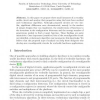Free Online Productivity Tools
i2Speak
i2Symbol
i2OCR
iTex2Img
iWeb2Print
iWeb2Shot
i2Type
iPdf2Split
iPdf2Merge
i2Bopomofo
i2Arabic
i2Style
i2Image
i2PDF
iLatex2Rtf
Sci2ools
EVOW
2008
Springer
2008
Springer
Analysis of Reconfigurable Logic Blocks for Evolvable Digital Architectures
Abstract. In this paper we propose three small instances of a reconfigurable circuit and analyze their properties using the brute force method and evolutionary algorithm. Although proposed circuits are very similar, significant differences were demonstrated, namely in the number of unique designs they can implement, the sensitiveness of functions to the inversions in the configuration bitstream and the average number of generations needed to find a target function. These findings are quite unintuitive. Once important (sensitive) bits of the reconfigurable circuit are identified, evolutionary algorithm can incorporate this knowledge. We believe that the proposed type of analysis can help those designers who develop new reconfigurable circuits for evolvable hardware applications.
Artificial Intelligence | Brute Force Method | Evolutionary Algorithm | EVOW 2008 | Reconfigurable Circuits |
| Added | 19 Oct 2010 |
| Updated | 19 Oct 2010 |
| Type | Conference |
| Year | 2008 |
| Where | EVOW |
| Authors | Lukás Sekanina, Petr Mikusek |
Comments (0)

